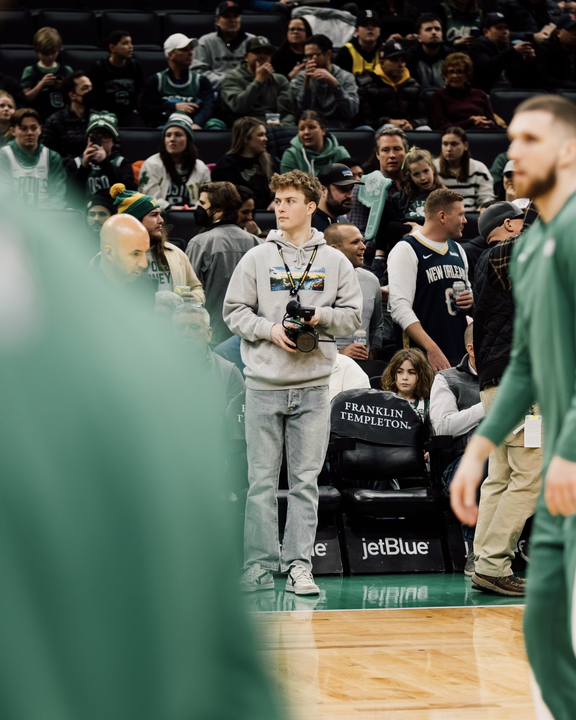By Sara Tucker, News Staff
The “Gravity” trailer, lacking a discernible plot, left viewers confused and a little unsure about the outcome of the newly released film starring Sandra Bullock and George Clooney.
Some predicted the film would be an hour and a half of Ryan Stone (Sandra Bullock) floating around in space after she’s disconnected from her ship and fellow astronaut Matthew Kowalski (George Clooney) – that much is clear from the trailer. But the film, released Oct. 4, turned out to be much more than that.
The opening of the film gives a brief summary about how space is completely silent as there are no faculties to carry sound, and how life in space is impossible. As the opening scene disappears, so does the music, which ends abruptly after a strong crescendo, showing a view of Earth from space.
After a brief pan, revealing the startlingly realistic effects that will accompany the entire film, Stone and Kowalski are shown doing routine work on the shuttle. The two are joking around with each other and “Houston” until the crew back on Earth suddenly aborts the mission because of debris headed straight for the American shuttle.
There are three named astronauts alive, as well as a crew aboard the shuttle, before the debris hits. Stone, Kowalski and Houston are the only ones with active dialogue, and the only ones left alive after the debris rips through the shuttle. For the remainder of the film, these are the only three characters, with a short sidebar from a Chinese man Stone encounters on a radio frequency. The lack of lots of dialogue contributes to the feeling of isolation present throughout the movie.
After the shuttle is ripped apart, Stone ends up floating through space, detached from the vessel, while Kowalski sets out to get her back. Luckily, Kowalski is sporting a thruster pack, which allows him to propel in space, while Stone is helpless and running out of oxygen.
Bullock worked her wonders at this point with dialogue between herself and Clooney on the radio, all while her oxygen levels are steadily decreasing. She reveals secrets about her past, her home and her deceased daughter while staring off towards Earth.
Because Stone is wearing a spacesuit for most of the film, cinematographers had a chance to use the reflective glass of her facemask to show approaching debris or a beautiful sunrise while simultaneously showing Stone’s reaction to the sight.
And those paying attention will notice that the whole movie is done in five takes, meaning the camera only cuts five times.
After Kowalski rescues Stone, the two head out towards the International Space Station a few hundred kilometers away, hoping to use its escape pod to get back to Earth. Clooney questions Stone about her life in Illinois and she answers begrudgingly, while giving the audience a countdown from 10 percent, as the oxygen in her tank is further depleted.
The miniscule number of participants in the plot becomes especially notable at this point, when the connection with Earth is lost. Directors decided on Bullock and Clooney with good reason: the actors had to be people the audience wouldn’t get tired of in the 91 minute film, because they’re sure as hell not hearing from anyone else.
After Stone and Kowalski reach the International Space Station, havoc strikes again. The seemingly inseparable duo get detached when Kowalski makes the decision to break the tether that attaches the two, and this time Stone is thrown into the role of hero.
And despite the fact that she’s in space in the negative hundreds of degrees, the directors didn’t miss a chance to get Bullock half naked – sporting compression shorts and a tight tank top after she sheds her space suit. It’s worth noting that this is pretty unrealistic, considering that real astronauts have to wear diapers in their space suits – there definitely aren’t any bathrooms breaks in this film.
Another stroke of bad luck befalls Stone when she chooses the wrong Soyuz escape vessel. Granted, the fire burning behind her may have made her directionally challenged, but this twist that wasn’t unexpected complicates Stone’s life further. Can’t a girl catch a break?
Since the escape pod she’s in has already had its parachute deployed, she can’t use it to get home, so she heads toward a Chinese station, which should have been relatively easy, until she realizes the pod is out of gas. She pretty much gives up at this point (who wouldn’t?), until a Chinese man she picks up on the radio with a dog and a baby, as well as a freakishly helpful hallucination of Kowalski, leave her with a solution to her dilemma, and renewed hope.
She makes it to the Chinese vessel, which is, of course, hurtling towards Earth after being struck by more of the Russian debris. She gets a bit toasty in the pod on the way down, and lands in the ocean, just a few feet offshore. But she nearly drowns when the pod fills up with water and her suit drags her to the ocean floor.
She swims to shore and the film concludes with Stone taking her first steps on land.
While some critics complain that the movie was nothing but CGI effects, and unworthy of the awards and praise that movies filmed on location deserve, the film was an apt portrayal of what today’s technological advances can do aside from making smart phones.
And what’s cooler than a space flick featuring two of America’s favorite actors?










